Question: 1
You have two Hyper-V hosts named Host1 and Host2. Host1 has an Azure virtual machine named VM1 that was deployed by using a custom Azure Resource
Manager template.
You need to move VM1 to Host2.
What should you do?
- A. From the Update management blade, click Enable.
- B. From the Overview blade, move VM1 to a different subscription.
- C. From the Redeploy blade, click Redeploy.
- D. From the Profile blade, modify the usage location.
Answer:
Correct Answer: C
When you redeploy a VM, it moves the VM to a new node within the Azure infrastructure and then powers it back on, retaining all your configuration options and associated resources.
Reference:
https://docs.microsoft.com/en-us/azure/virtual-machines/windows/redeploy-to-new-node
Question:2
DRAG DROP -
You have downloaded an Azure Resource Manager template to deploy numerous virtual machines. The template is based on a current virtual machine, but must be adapted to reference an administrative password.
You need to make sure that the password is not stored in plain text.
You are preparing to create the necessary components to achieve your goal.
Which of the following should you create to achieve your goal? Answer by dragging the correct option from the list to the answer area.
Select and Place:
Answer:
Question:3
Your company has an Azure Kubernetes Service (AKS) cluster that you manage from an Azure AD-joined device. The cluster is located in a resource group.
Developers have created an application named MyApp. MyApp was packaged into a container image.
You need to deploy the YAML manifest file for the application.
Solution: You install the Azure CLI on the device and run the kubectl apply `"f myapp.yaml command.
Does this meet the goal?
A. Yes
B. No
Correct Answer: A
kubectl apply -f myapp.yaml applies a configuration change to a resource from a file or stdin.
Reference:
https://kubernetes.io/docs/reference/kubectl/overview/
https://docs.microsoft.com/en-us/cli/azure/aks
Question: 4
Your company has an Azure Kubernetes Service (AKS) cluster that you manage from an Azure AD-joined device. The cluster is located in a resource group.
Developers have created an application named MyApp. MyApp was packaged into a container image.
You need to deploy the YAML manifest file for the application.
Solution: You install the docker client on the device and run the docker run -it microsoft/azure-cli:0.10.17 command.
Does this meet the goal?
- A. Yes
- B. No
Correct Answer: B
Question: 5
Your company has a web app named WebApp1.
You use the WebJobs SDK to design a triggered App Service background task that automatically invokes a function in the code every time new data is received in a queue.
You are preparing to configure the service processes a queue data item.
Which of the following is the service you should use?
- A. Logic Apps
- B. WebJobs
- C. Flow
- D. Functions
Correct Answer: B
Reference:
https://docs.microsoft.com/en-us/azure/azure-functions/functions-compare-logic-apps-ms-flow-webjobs
Question: 6
Your company has an Azure subscription.
You need to deploy a number of Azure virtual machines to the subscription by using Azure Resource Manager (ARM) templates. The virtual machines will be included in a single availability set.
You need to ensure that the ARM template allows for as many virtual machines as possible to remain accessible in the event of fabric failure or maintenance.
Which of the following is the value that you should configure for the platformFaultDomainCount property?
- A. 10
- B. 30
- C. Min Value
- D. Max Value
Correct Answer: D
The number of fault domains for managed availability sets varies by region - either two or three per region.
Reference:
https://docs.microsoft.com/en-us/azure/virtual-machines/windows/manage-availability
Question: 7
Your company has an Azure subscription.
You need to deploy a number of Azure virtual machines to the subscription by using Azure Resource Manager (ARM) templates. The virtual machines will be included in a single availability set.
You need to ensure that the ARM template allows for as many virtual machines as possible to remain accessible in the event of fabric failure or maintenance.
Which of the following is the value that you should configure for the platformUpdateDomainCount property?
- A. 10
- B. 20
- C. 30
- D. 40
Correct Answer: D 🗳️
Each virtual machine in your availability set is assigned an update domain and a fault domain by the underlying Azure platform. For a given availability set, five non-user-configurable update domains are assigned by default (Resource Manager deployments can then be increased to provide up to 20 update domains) to indicate groups of virtual machines and underlying physical hardware that can be rebooted at the same time.
Reference:
https://docs.microsoft.com/en-us/azure/virtual-machines/windows/manage-availability
Question:8
DRAG DROP -
You are creating an Azure Cosmos DB account that makes use of the SQL API. Data will be added to the account every day by a web application.
You need to ensure that an email notification is sent when information is received from IoT devices, and that compute cost is reduced.
You decide to deploy a function app.
Which of the following should you configure the function app to use? Answer by dragging the correct options from the list to the answer area.
Select and Place: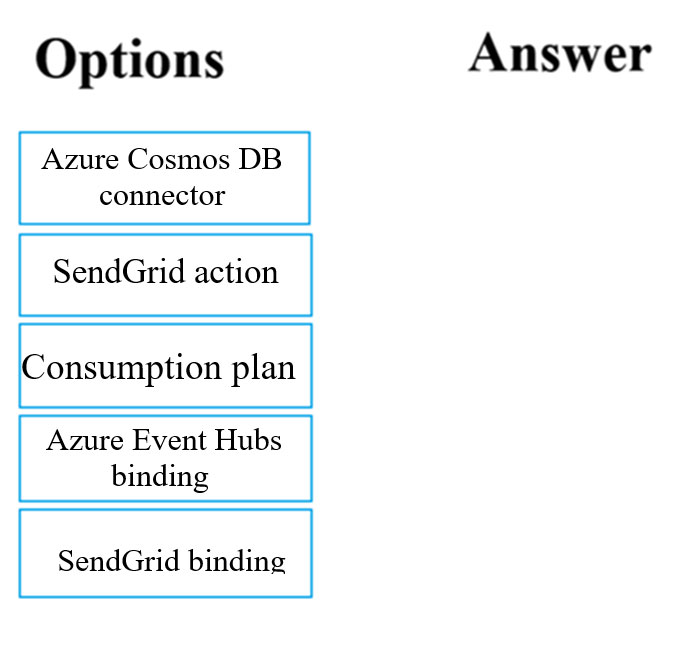
Correct Answer: 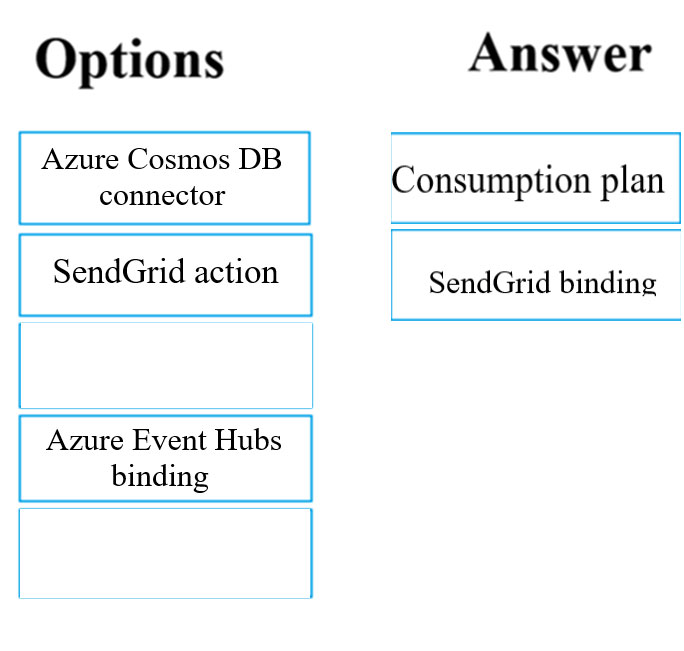
Question:9
This question requires that you evaluate the underlined text to determine if it is correct.
You company has an on-premises deployment of MongoDB, and an Azure Cosmos DB account that makes use of the MongoDB API.
You need to devise a strategy to migrate MongoDB to the Azure Cosmos DB account.
You include the Data Management Gateway tool in your migration strategy.
Instructions: Review the underlined text. If it makes the statement correct, select `No change required.` If the statement is incorrect, select the answer choice that makes the statement correct.
- A. No change required
- B. mongorestore
- C. Azure Storage Explorer
- D. AzCopy
Correct Answer: B
Reference:
https://docs.microsoft.com/en-us/azure/cosmos-db/mongodb-migrate https://docs.mongodb.com/manual/reference/program/mongorestore/
Question:10
You are developing an e-Commerce Web App.
You want to use Azure Key Vault to ensure that sign-ins to the e-Commerce Web App are secured by using Azure App Service authentication and Azure Active
Directory (AAD).
What should you do on the e-Commerce Web App?
- A. Run the az keyvault secret command.
- B. Enable Azure AD Connect.
- C. Enable Managed Service Identity (MSI).
- D. Create an Azure AD service principal.
Correct Answer: C
A managed identity from Azure Active Directory allows your app to easily access other AAD-protected resources such as Azure Key Vault.
Reference:
https://docs.microsoft.com/en-us/azure/app-service/overview-managed-identity https://docs.microsoft.com/en-us/samples/azure-samples/app-service-msi-keyvault-dotnet/keyvault-msi-appservice-sample/
Question:11
This question requires that you evaluate the underlined text to determine if it is correct.
Your Azure Active Directory Azure (Azure AD) tenant has an Azure subscription linked to it.
Your developer has created a mobile application that obtains Azure AD access tokens using the OAuth 2 implicit grant type.
The mobile application must be registered in Azure AD.
You require a redirect URI from the developer for registration purposes.
Instructions: Review the underlined text. If it makes the statement correct, select `No change is needed.` If the statement is incorrect, select the answer choice that makes the statement correct.
- A. No change required.
- B. a secret
- C. a login hint
- D. a client ID
Correct Answer: A
For Native Applications you need to provide a Redirect URI, which Azure AD will use to return token responses.
Reference:
https://docs.microsoft.com/en-us/azure/active-directory/develop/v1-protocols-oauth-code
Question:12
You are creating an Azure key vault using PowerShell. Objects deleted from the key vault must be kept for a set period of 90 days.
Which two of the following parameters must be used in conjunction to meet the requirement? (Choose two.)
- A. EnabledForDeployment
- B. EnablePurgeProtection
- C. EnabledForTemplateDeployment
- D. EnableSoftDelete
Correct Answer: B and D
Reference:
https://docs.microsoft.com/en-us/powershell/module/azurerm.keyvault/new-azurermkeyvault https://docs.microsoft.com/en-us/azure/key-vault/key-vault-ovw-soft-delete
Question:13
HOTSPOT -
You have an Azure Active Directory (Azure AD) tenant.
You want to implement multi-factor authentication by making use of a conditional access policy. The conditional access policy must be applied to all users when they access the Azure portal.
Which three settings should you configure? To answer, select the appropriate settings in the answer area.
NOTE: Each correct selection is worth one point.
Hot Area: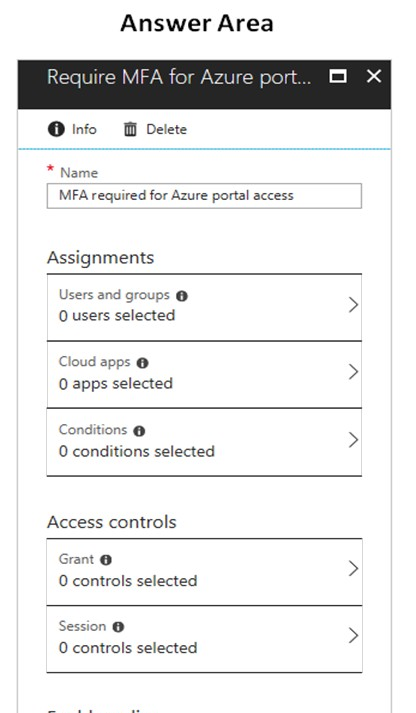
er: 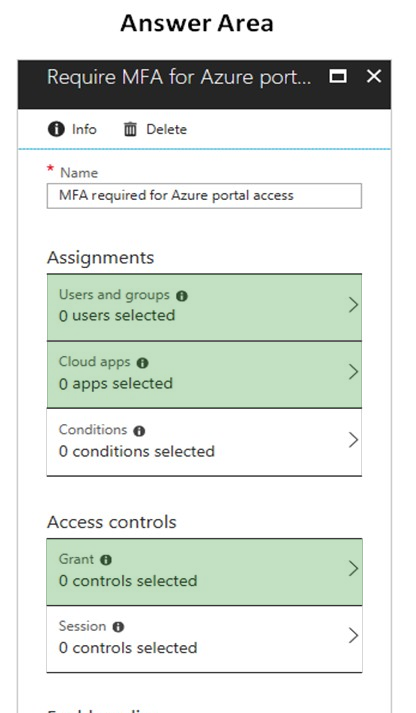
Box 1:
The conditional access policy must be applied or assigned to Users and Groups.
Box 2:
The conditional access policy must be applied when users access the Azure portal, which is a cloud app. That is: Microsoft Azure Management
Box 3:
Access control must require multi-factor authentication when granting access.
Reference:
https://docs.microsoft.com/en-us/azure/active-directory/conditional-access/app-based-mfa
Question:14
You manage an Azure SQL database that allows for Azure AD authentication.
You need to make sure that database developers can connect to the SQL database via Microsoft SQL Server Management Studio (SSMS). You also need to make sure the developers use their on-premises Active Directory account for authentication. Your strategy should allow for authentication prompts to be kept to a minimum.
Which of the following should you implement?
- A. Azure AD token.
- B. Azure Multi-Factor authentication.
- C. Active Directory integrated authentication.
- D. OATH software tokens.
Correct Answer: C
Azure AD can be the initial Azure AD managed domain. Azure AD can also be an on-premises Active Directory Domain Services that is federated with the Azure
AD.
Using an Azure AD identity to connect using SSMS or SSDT
The following procedures show you how to connect to a SQL database with an Azure AD identity using SQL Server Management Studio or SQL Server Database
Tools.
Active Directory integrated authentication
Use this method if you are logged in to Windows using your Azure Active Directory credentials from a federated domain.
1. Start Management Studio or Data Tools and in the Connect to Server (or Connect to Database Engine) dialog box, in the Authentication box, select Active
Directory - Integrated. No password is needed or can be entered because your existing credentials will be presented for the connection.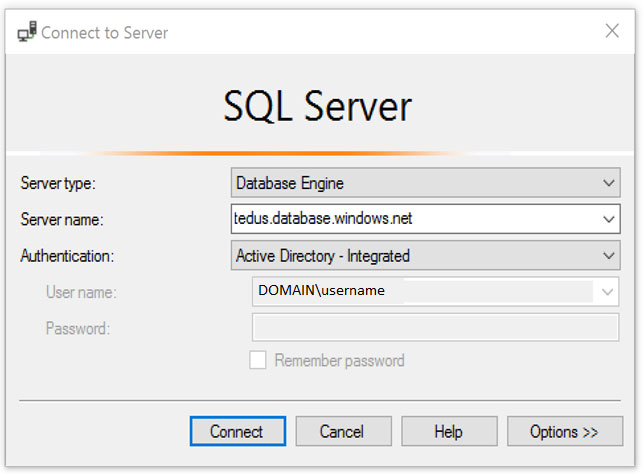
2. Select the Options button, and on the Connection Properties page, in the Connect to database box, type the name of the user database you want to connect to.
(The AD domain name or tenant IDג€ option is only supported for Universal with MFA connection options, otherwise it is greyed out.)
Question:15
You are developing an application to transfer data between on-premises file servers and Azure Blob storage. The application stores keys, secrets, and certificates in Azure Key Vault and makes use of the Azure Key Vault APIs.
You want to configure the application to allow recovery of an accidental deletion of the key vault or key vault objects for 90 days after deletion.
What should you do?
- A. Run the Add-AzKeyVaultKey cmdlet.
- B. Run the az keyvault update --enable-soft-delete true --enable-purge-protection true CLI.
- C. Implement virtual network service endpoints for Azure Key Vault.
- D. Run the az keyvault update --enable-soft-delete false CLI.
Correct Answer: B
When soft-delete is enabled, resources marked as deleted resources are retained for a specified period (90 days by default). The service further provides a mechanism for recovering the deleted object, essentially undoing the deletion.
Purge protection is an optional Key Vault behavior and is not enabled by default. Purge protection can only be enabled once soft-delete is enabled.
When purge protection is on, a vault or an object in the deleted state cannot be purged until the retention period has passed. Soft-deleted vaults and objects can still be recovered, ensuring that the retention policy will be followed.
The default retention period is 90 days, but it is possible to set the retention policy interval to a value from 7 to 90 days through the Azure portal. Once the retention policy interval is set and saved it cannot be changed for that vault.
Reference:
https://docs.microsoft.com/en-us/azure/key-vault/general/overview-soft-delete



